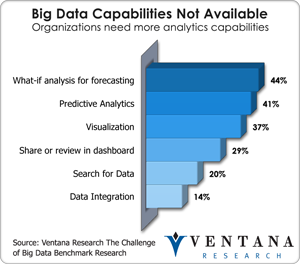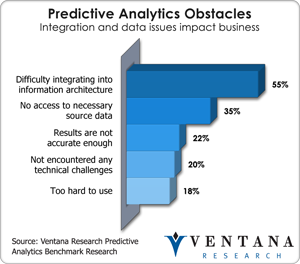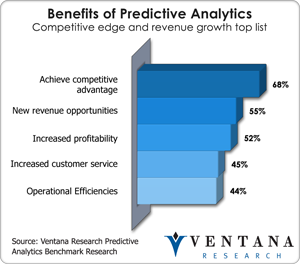In our benchmark research in predictive analytics we’ve uncovered some intriguing tools for taking advantage of big data in the enterprise. Revolution Analytics, which we analyzed earlier this year, this month  introduced its 6.0 release. Revolution extends the open source statistical programming language R with capabilities you would expect out of enterprise software. The company has grown substantially over the last several years and has an impressive list of more than a hundred customers in both the private and public sectors. Revolution partners with database and data integration providers such as Talend and Informatica and business intelligence providers who want to connect to more advanced level of analytics. Revolution can operate across a range of big data architectures, including Hadoop, working with Cloudera and IBM as well as data warehouse appliances such as IBM Netezza and Teradata. This is a smart move, since predictive analytics is the second most important unavailable capability cited by big data deployments in to our benchmark research.
introduced its 6.0 release. Revolution extends the open source statistical programming language R with capabilities you would expect out of enterprise software. The company has grown substantially over the last several years and has an impressive list of more than a hundred customers in both the private and public sectors. Revolution partners with database and data integration providers such as Talend and Informatica and business intelligence providers who want to connect to more advanced level of analytics. Revolution can operate across a range of big data architectures, including Hadoop, working with Cloudera and IBM as well as data warehouse appliances such as IBM Netezza and Teradata. This is a smart move, since predictive analytics is the second most important unavailable capability cited by big data deployments in to our benchmark research.
With version 6, Revolution Analytics can now operate across grids of computing technology supporting Platform Computing’s LSF (Load Sharing Facility) clusters for analytic jobs operating across Linux servers. Revolution also can be managed within Microsoft HPC Server management tools to  operate in the Azure Cloud to get more elasticity in compute power. Users can prototype locally then deploy into test and production environments. Revolution supports generalized linear models (GLM) to help with the design and deployability of predictive analytics. To support the largest obstacle reported by organizations in our benchmark research, difficulty integrating into information architectures, Revolution supports non-XDF (eXtensible Data Format) data sources, with direct support of ASCII and ODBC but also SAS and SPSS without having to install those platforms. If needed, data can be transformed to XDF format for further analytics in Revolution. For tighter integration with Hadoop, Revolution built RevoConnectR, which allows customers not just to integrate with HDFS but also import tables via Apache HBASE and write map-reduce tasks from within R. All of these advancements in version 6 help broaden the potential for not just the design and modeling aspect of Revolution but also for supporting deployment of the models in business processes.
operate in the Azure Cloud to get more elasticity in compute power. Users can prototype locally then deploy into test and production environments. Revolution supports generalized linear models (GLM) to help with the design and deployability of predictive analytics. To support the largest obstacle reported by organizations in our benchmark research, difficulty integrating into information architectures, Revolution supports non-XDF (eXtensible Data Format) data sources, with direct support of ASCII and ODBC but also SAS and SPSS without having to install those platforms. If needed, data can be transformed to XDF format for further analytics in Revolution. For tighter integration with Hadoop, Revolution built RevoConnectR, which allows customers not just to integrate with HDFS but also import tables via Apache HBASE and write map-reduce tasks from within R. All of these advancements in version 6 help broaden the potential for not just the design and modeling aspect of Revolution but also for supporting deployment of the models in business processes.
Achieving a competitive advantage, identifying  new revenue opportunities and increasing profitability are the top benefits we found in our benchmark on the value of predictive analytics. Predictive analytics help businesses to be more intelligent about the decisions they make every day. Revolution, with its latest release, provides more flexibility and openness to its technology while becoming more integrated with the range of platform and information architectures that IT organizations operate with today and that they will use in the future.
new revenue opportunities and increasing profitability are the top benefits we found in our benchmark on the value of predictive analytics. Predictive analytics help businesses to be more intelligent about the decisions they make every day. Revolution, with its latest release, provides more flexibility and openness to its technology while becoming more integrated with the range of platform and information architectures that IT organizations operate with today and that they will use in the future.
Regards,
Mark Smith – CEO & Chief Research Officer













